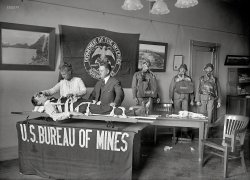
MAY CONTAIN NUTS

Search Shorpy
SHORPY ART

Framed or unframed, desk size to sofa size, printed by us in Arizona and Alabama since 2007. Explore now.
Join and Share
Ad-Free Shorpy
Shorpy is funded by you. Patreon contributors get an ad-free experience.
Learn more.

Recent comments
- Baldwin 62303
- Baldwin VO-1000
- Cold
- No expense spared
- Tough Guys
- Lost in Toyland
- And without gloves
- If I were a blindfolded time traveler
- Smoke Consumer Also Cooks
- Oh that stove!
- Possibly still there?
- What?!?
- $100 Reward
- Freeze Frame
- Texas Flyer wanted
- Just a Year Too Soon
- WWII -- Replacing men with women at the railroad crossing.
- Yes, Icing
- You kids drive me nuts!
- NOT An Easy Job
- I wonder
- Just add window boxes
- Icing Platform?
- Indiana Harbor Belt abides
- Freezing haze
- Corrections (for those who care)
- C&NW at Nelson
- Fallen Flags
- A dangerous job made worse
- Water Stop
Member Photos
The Shorpy
Print Emporium
Print Emporium
Search Shorpy
Search results -- 30 results per page
- Lincoln in Virginia: 1926
- ... more, the present owner signed the paperwork so that the interior woodwork, mantels, etc. are likewise protected from being "updated" by ... Posted by Dave - 08/05/2012 - 7:54pm -
![Lincoln in Virginia: 1926 Alexandria, Virginia, circa 1926. "Dr. Fairfax home (Ford Motor Co.)" From a series of photographs, taken for Ford Motor Co., showing Alexandria landmarks. The car here is a Lincoln. National Photo glass negative. View full size.
SimpleVery nicely done entry recess, but those shutters on the top really jar the eye.
Harry LeePleasant surprise seeing this pic. I just found a few days ago this person is a relative. Thanks for sharing!
Federal StyleLovely Federal (or is it Georgian?) style architecture!
Things probably only a carpenter sees...It appears this was a time when shutters were becoming more decorative than functional. Telltale signs of non-use are the bird droppings and needed repairs, plus there are no knobs or latches to hold them shut if they were closed. And that broken piece of lumber along the roof edge raises a few questions about why it's there, what or who broke it off, and how does the bent gutter work into the mystery? And only one screen, second floor left window?
Time stands stillI live a couple blocks up from this home, and aside from a much more lush garden on the right side yard, it looks identical to this photo. Being over 100 years old, the exterior is protected from being modified. What's more, the present owner signed the paperwork so that the interior woodwork, mantels, etc. are likewise protected from being "updated" by future owners.
HardwareI'm seeing all kinds of hardware for holding the shutters in the hi-res version of the picture.
[Another thing: The tall righthand middle shutter moved during the exposure. - Dave]
+89Below is the same view from October of 2015.
(The Gallery, Cars, Trucks, Buses, Natl Photo)](https://www.shorpy.com/files/images/32588u.thumbnail.jpg)
- And Step On It: 1917
- ... board. Don't you just love the brocade upholstered interior? How about my walking stick and buttoned gloves? The pince-nez? And ... Posted by Dave - 05/17/2016 - 8:27pm -
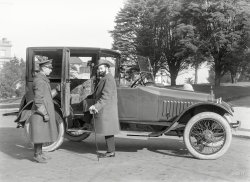
- Hobo King: 1924
- ... wanderer visited the Secretaries of State, War, Navy and Interior, in an effort to secure better legislation for the hoboes of the ... Posted by Dave - 05/01/2013 - 8:33am -
![Hobo King: 1924 August 1924. Washington, D.C. Jeff Davis, self-styled Hobo King (as well as founder of various Hotels de Gink, a chain of hostels for the homeless), standing next to his jalopy and driver. Harris & Ewing glass negative. View full size.
BuildingI believe that the out-of-focus building in the background is the U.S. National Conservatory, located immediately adjacent to the Capitol.
[Looks more like the Renwick Gallery at 17th Street and Pennsylvania Avenue NW. -tterrace]
Car?Does that say "WO" on the front? It doesn't look like a Willys Knight insignia, but it also looks like it might be painted on. The headlights are similar to a 1918-ish Willys, but the concave grille is not. Little help?
[It's a REO. -tterrace]
FascinatingI was so fascinated by this picture that I researched him and the Hotels. I created a Wikipedia article with a few of the sources. Feel free to expand it:
http://en.wikipedia.org/wiki/Hotel_de_Gink
Custom REOIt appears to be a Reo touring body mounted on a truck chassis (White?). Something easily done "back in the day."
Classy is as classy doesHe may be the Hobo King, but his car says he's "now traveling Delux." Amen to that.
Hoboes, Tramps & Bums
Washington Post, February 26, 1915.
“Hobo King” Sees President
Jeff Davis, “king of the hoboes” and founder of the Hotel de Gink, for the unemployed of New York, was received by President Wilson yesterday morning. After his visit to the White House the wanderer visited the Secretaries of State, War, Navy and Interior, in an effort to secure better legislation for the hoboes of the country.
Davis asked the President to set aside some public lands for a “Farm de Gink” for the use of the unemployed. He later discussed his project with other cabinet officers.
“Christopher Columbus was a sea hobo before he was the discoverer of America,” Davis told the President. “The unemployed are divided into three classes—hoboes who are willing to work; tramps who won't work, and bums who can't work. We are doing our best to assist the hoboes who are entitled to help from the government. Any man is apt to become a hobo at some time.” …
(The Gallery, Cars, Trucks, Buses, D.C., Harris + Ewing, On the Road)](https://www.shorpy.com/files/images/SHORPY_44426a.thumbnail.jpg)
- On the Beach: 1904
- ... we became well-acquainted with artificially changing our interior environments to "iceboxes" in warm weather. I came to this conclusion ... Posted by Dave - 05/16/2010 - 10:07am -
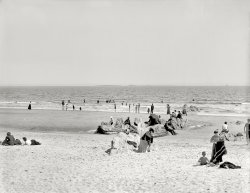
- Fine Arts: 1903
- ... It's still beautiful inside, with most of the original interior quite intact, including in the private offices. It's worth a visit if ... Posted by Dave - 04/11/2018 - 8:39pm -
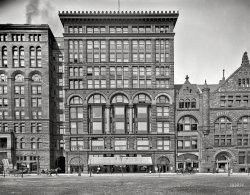
- Pinned: 1943
- ... is what brightened his day.
AT&SF Rocks! The interior of this caboose seems much brighter and better kept than most of the ... Posted by Dave - 10/04/2014 - 5:07pm -
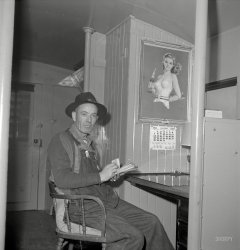
- Winchester Mystery House: 1959
- I have a vivid memory of the interior of the Winchester Mystery House in San Jose, California which we ... me would remember a half-century later! Some views of the interior, and the story behind the mystery house, can be glimpsed here .
... Posted by Rute Boye - 09/21/2012 - 9:34pm -
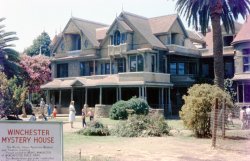
- Newark Luxe: 1944
- ... and blonde 1944 furniture with the intricately beautiful interior and lighting fixtures of an obviously 1920's or earlier building.
... Posted by Dave - 09/15/2014 - 6:01am -
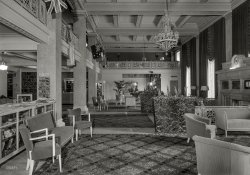
- Wreck on the Highway: 1939
- ...
Additional Views Here Some additional exterior and interior views here: https://www.loc.gov/resource/hhh.al0705.photos/?sp=1 ... Posted by Dave - 04/11/2019 - 10:16am -
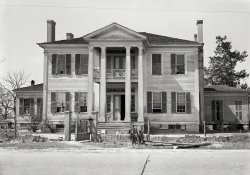
- Union Garage: 1924
- ... seems to be 613-621 G street.
Elsewhere on Shorpy: The interior is also seen in this photo of the Semmes service department. ... Posted by Dave - 09/12/2011 - 12:06pm -
![Union Garage: 1924 Washington circa 1924. "Union Garage." The Union Building on G Street, venue for the 1917 Auto Show. In July 1917 it was taken over by the Semmes Motor Company, offering 24-hour repair service as well as showrooms for Dodge and Hudson cars. National Photo Company glass negative. View full size.
Union BuildingWow, so much to see in this photo. I love the old skyline shots.
The Union Building was erected in 1892-93 at the suggestion of the Postmaster General, who wanted space for a new city post office. It was initially run by a private company and rented to the federal government. Congressional investigations in 1911 revealed that the government was being ripped off by exorbitant rent for the building and suggested this might be due to political connections of the buildings owners. Converted to garage in 1915 and purchased by Semmes Motor Company in 1919. The address range seems to be 613-621 G street.
Elsewhere on Shorpy: The interior is also seen in this photo of the Semmes service department. Also an article on Semmes plans to update the building as a "modern" service station.
And that rhymes with "P"How convenient - you can play a game of pool next door while you're waiting for your flivver to be fixed!
Market BuildingIs that the old market building, later the wax museum in the Mount Vernon triangle, peeking up above the garage in the background?
[You mean the Liberty Market at Fifth and K? Yes it is. - Dave]
Union Garage: 1924What cemetery is that in the background, and what's the huge building far away with the colonial tower?
[I see a lot of tents in the background. Maybe Camp Meigs. I'm not sure about a cemetery. - Dave]
Adverti$ingThomas Cusack was quite the entrepreneur. Started in 1875, with nothing but a paintbrush and ambition, and now the company is worth $26 million.
Verizon HorizonThis whole block is now the Verizon Center, where the Washington Wizards and Capitals play. On the right is my church, St. Mary's. It used to serve the German Catholic Population in Washington. It was still a German-speaking parish when this photo was taken. The building immediately to the right of the church is the old school and to the left is the rectory. I believe the domed building behind and just to the left of the Union Building (partially obscured) is the historic 6th and I synagogue. Most everything else is gone.
(The Gallery, Cars, Trucks, Buses, D.C., Natl Photo)](https://www.shorpy.com/files/images/31909u.thumbnail.jpg)
- Beam Me Up: 1940
- ... & Co., Newark, New Jersey. Quality Dress Salon. Interior view. Raymond Loewy Corp., architect." Eljay Photo Service. View ... Posted by Dave - 08/12/2013 - 12:33pm -
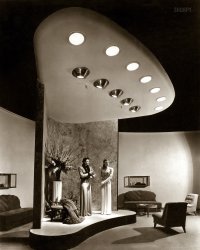
- Paradise P.O.: 1940
- ... outside chimney helped prevent the spread of fire to the interior of the building. A common practice to contain a chimney fire was to ... Posted by Dave - 11/29/2020 - 1:14pm -
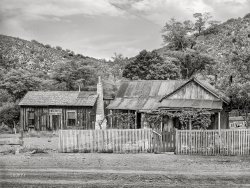
- In Dutch: 1920
- Washington, D.C., circa 1920. "Old Dutch Market, interior, Ninth & G Streets N.W." Multiple familiar faces here, all ... Posted by Dave - 03/15/2017 - 11:19am -
![In Dutch: 1920 Washington, D.C., circa 1920. "Old Dutch Market, interior, Ninth & G Streets N.W." Multiple familiar faces here, all belonging to Aunt Jemima. National Photo Company Collection glass negative. View full size.
Sawdust on the floorTaverns and grocery stores used to have a layer of sawdust spread on the floor, I suppose to sop up spills. It certainly doesn't do much for pedestrian traction.
A recall a "Gay 90s" song, probably composed nostalgically well after that time, which went something like "Put that sawdust back on the floor, / Or we won't come here anymore." One suspects that the composer's favorite gin mill had recently gone all fern-bar on him.
Yes! we have noLooks like those are red bananas hanging on the right. Once as popular as the yellow ones we seem to only see anymore.
Taylor Pork Taylor Pork Roll. An import from New Jersey. Brings me back to my Rutgers days.
Porky pig"Don't forget your Taylor pork"
A smaller sign located near center of picture. I guess most pork was salt pork because I don't think refrigeration was very advanced then.
And why are the employees behind glass, that is strange considering most help then was a hands on type help.
Love Shorpy......Long live Shorpy.
[The people in the glass box are the cashiers. -tterrace]
Healthy AuntieThough not from that far back, I do remember the healthy-looking Aunt Jemima (like the one on these boxes) from my youth, and then they slimmed her down and she looked ill to me. I miss my old Aunt Jemima!
Makes My Mouth WaterAs a photographic restorer of old photos, this makes my mouth water, and not because of the challenge but all that delicious food that you don't see any more.
(The Gallery, D.C., Natl Photo, Stores & Markets)](https://www.shorpy.com/files/images/SHORPY-29616u.thumbnail.jpg)
- Cat Nap: 1936
- April 1936. "Interior of rehabilitation client's cabin. Jackson County, Ohio." A close-up of ... Posted by Dave - 12/10/2007 - 6:30pm -
![Cat Nap: 1936 April 1936. "Interior of rehabilitation client's cabin. Jackson County, Ohio." A close-up of the little girl's room shown four pictures down. 35mm nitrate negative by Theodor Jung, Resettlement Administration. View full size.
love the little pup curledlove the little pup curled up in a fetal position.
[That's a cat. - Dave]
(The Gallery, Cats, Theodor Jung)](https://www.shorpy.com/files/images/8a14196u_0.thumbnail.jpg)
- The Boudoir: 1940
- ... Dan Cooper, decorator; Edward D. Stone, architect." Interior of the Rockefeller Center ranch house last glimpsed here . ... Posted by Dave - 11/16/2013 - 11:17am -
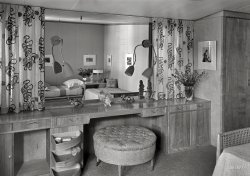
- Red and Blue: 1942
- ... Fiber Waco vermillion w/ correct black trim. Grey velour interior. Original rear seat. Original NC registration number on tail and ... Posted by Dave - 02/08/2008 - 10:48pm -
![Red and Blue: 1942 June 1942. Bar Harbor, Maine. Plane of Coast Patrol #20 at the Civil Air Patrol base. View full size. 4x5 Kodachrome transparency by John Collier.
That plane isA Waco YQC-6 [NC16576] (1936).
Here's another view:
This aircraft still fliesI found a sale listing for this Waco (current on Oct. 9, 2011) on the site of the American WACO Club. I like the site motto, "After the last WACO gracefully flies, the sky will become merely air."
For Sale: 1936 Waco YKS-6 NC16576. TTAF 1344 26 hours since complete restoration by Russ Harmuth to specs and condition of original factory delivery order. Log books. 245hp Jacobs R755-9, MOH by Aero Engines, HamStd 2B-20. Engine operating and maintenance manual. "Eyeball" air vents. AmeriKing ELT, TDR Txpdr, Garmin GNC 250 GPS/COM. PS Engineering PM1000 II, Back lit panel. Instruments overhauled by Instrument Pro and screened with "radium color" print and logo. Cessna 310 wheels & brakes, Wheel pants, Locking tail wheel,
Grimes retractable landing lights. Original nav lights. Strobes. Poly Fiber Waco vermillion w/ correct black trim. Grey velour interior. Original rear seat. Original NC registration number on tail and wings. Original operable speed brakes. O'hauled Curtiss-Reed prop available. $120,000.
(The Gallery, Kodachromes, Aviation, John Collier, WW2)](https://www.shorpy.com/files/images/1a34551u1_0.thumbnail.jpg)
- Handyman's Special: 1936
- ... is shabby and in dire need of repair, but my guess is the interior is clean and tidy. Look at the clean, ironed curtains in the windows. ... Posted by Dave - 12/13/2015 - 2:18pm -
![Handyman's Special: 1936 February 1936. "Shabby housing near Bound Brook, New Jersey." Medium format negative by Carl Mydans for the Resettlement Administration. View full size.
PaintWere these houses ever painted?
NEW TO MARKET! 4BR, 2.5 BA Bound Brook fixer-upper $179,900BOUND BROOK - This charming, century-old home is looking for the perfect buyers who aren't afraid to get their hands dirty.
This home with great bones has four bedrooms, one full bath upstairs, a master bedroom ensuite bath and walk-in closet, and a downstairs powder room, large eat-in kitchen, fireplaced living room and formal dining area. The basement is unfinished, and has lots of family room / man cave potential!
Exterior features include period details and trim, wood windows with shutters, gorgeous double front doors, a large covered porch and trellised sun deck. Big yard with lots of landscape opportunities!
Bring your open mind and your tool belt and have a painting party! Home will be sold as-is, no home warranty. Contact Shorpy Real Estate for details, ask for Mr. Higginbotham!
For The Growing FamilyIt appears someone removed the upstairs shutters for the latest update and aluminum siding. With the window curtains and rods already there, a cuboard stocked with cans of beans, and a really nice porch swing this could be a good buy.
A shovel and rake are handy for cleaning up the yard.
The good part is there are no HOA rules in this location and the nearest neighbor is a mile away.
You Can't Judge a Book By It's CoverThe exterior is shabby and in dire need of repair, but my guess is the interior is clean and tidy. Look at the clean, ironed curtains in the windows. The shades are clean too. The shades and curtains are hung straight. Somebody is working to keep it up on the inside.
Still ProudUnmaintained, but this old girl was built with pride and was probably the talk of the town when built. Great trim detail, the roof line we see is still unwavering.
I doubt todays chipboard McMansions will fare as well left unattended.
Didn't I see this place....in "Mr. Smith Builds his Dream House"????
[Or in "Mr. Blandings goes to Washington," perhaps. -tterrace]
The Gothic-arched minature door by the front doorThat little gothic-arched door and frame resting against the wall next to the front door may be a cast-iron coal-burning fireplace front.
There was a time when fireplaces, as opposed to stoves, for coal were built around a cast-iron insert with a door. There were grates inside for the coal fire.
(The Gallery, Carl Mydans)](https://www.shorpy.com/files/images/SHORPY-8b26924a.thumbnail.jpg)
- Grand Exit: 1920
- ... - probably a Model 45-B. This had a box pleated leather interior and the tops of the doors were also leather. There were two ... Posted by Dave - 03/01/2015 - 11:54am -
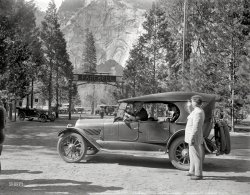
- The Hold: 1906
- ... this.
Mystery boards A fascinating view of the vast interior storage area of a steam ship. I'm surprised both by how large it is ... Posted by Dave - 07/22/2012 - 7:14pm -
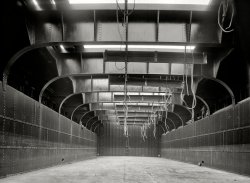
- Northward Ho (Colorized): 1905
- ... you!
One small change please The Minister of the Interior asked me to discreetly inquire if you could change the appearance of ... Posted by Dennis Klassen - 02/06/2011 - 7:06pm -
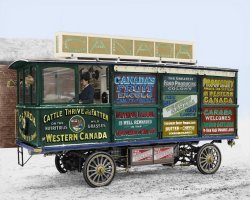
- Green Cars: 1920
- "Trew Motor Co. interior." Circa 1920, the Reo automobile showroom (and conservatory) in Joseph ... Posted by Dave - 09/04/2012 - 12:57pm -
![Green Cars: 1920 "Trew Motor Co. interior." Circa 1920, the Reo automobile showroom (and conservatory) in Joseph Trew's new three-story building at 14th and P Streets N.W. in Washington. National Photo Company glass negative. View full size.
Trew BuildingA 1923 Washington Post article says this building, then described as new, was at 1509 Fourteenth Street, the site of the present Studio Theater.
[Below, a 1920 article on the new building. - Dave]
Ransom Eli OldsREO: Ransom Eli Olds. The Oldsmobile is also named after him. He, not Henry Ford, developed the first assembly line.
Anti-theft Potted PlantsMan, they sure were nuts about ferns and palms in the teens and 20s, weren't they? They were almost as much a part of the era's style as were fringy lampshades and ugly hats on women. (The lampshades could be on lamps or women—you pick.)
Reo SpeedwagonWhen I was a teenager in the 60's, my best friend's dad had a Reo Speedwagon, mid-1920s but not sure. It had a straight four, not the later six they came out with. The two things I remember about it was it had exposed rocker arms above the engine head that were lubricated by drip cups. Before starting, a rocker valve was raised that opened the valve in the glass cups which "dripped" oil onto the rocker arms every few seconds. The other thing I remember was that the traditional H pattern of most floor shifts was mirror image. 1st was at the forward right, 2nd was back right, 3rd was left forward, etc. Made for fun shifting switching back & forth between the Reo and my VW.
(The Gallery, Cars, Trucks, Buses, D.C., Natl Photo)](https://www.shorpy.com/files/images/30553u.thumbnail.jpg)
- J-Ride: 1950
- ... trunk lids and glove boxes and also had a higher grade interior. They could be had with a 134 cubic inch four or 161 cubic inch six, ... Posted by Dave - 11/04/2013 - 7:50am -
![J-Ride: 1950 Publicity photo from late 1950 for the Kaiser "Henry J," a small car (named after company chairman Henry J. Kaiser) that was a few years ahead of its time. By 1954, the Henry J had tootled off into oblivion. View full size.
Basic transportation for sureApparently Henry J. Kaiser hoped to become known as the next Henry Ford, or American answer to Adolph Hitler, when he wisely sought to produce a low-priced new car for low-income folks shortly after World War II ended.
But the first models of the Henry J. had no trunk lid, so you'd access that area by folding down the back seat. Also, the rear windows didn't roll down, there was no glove compartment and no arm rests either.
A friend of mine owned a used Henry J in the early 1960s and it was a fun car to buzz around in. But our OSHA and highway safety people wouldn't let Americans even near one if they tried to market them now. They were made and sold for only four years.
Quite possiblythe worst looking automobile in history, and there were plenty to choose from.
Darrin influenceAlthough the Henry J prototype wasn’t a Dutch Darrin design, he did tweak it a bit. The signature ‘Darrin Dip’ at the trailing edge of the door betrays his involvement. As well, he is credited for insisting on the rear fender mini fins.
AllstateIf you didn't like the bare bones austerity of the Henry J, then beginning in 1952 you could buy a more nicely equipped variant at your local Sears store with the name Allstate in its place. Most of the Allstates came with trunk lids and glove boxes and also had a higher grade interior. They could be had with a 134 cubic inch four or 161 cubic inch six, which probably resulted in a nice power to weight ratio for the 2,300 lb. car considering that the almost 600 lb. heavier Studebaker Champion only had eight more cubic inches. 1566 were built in 1952 and only 797 early in 1953 when Sears discontinued the program of selling a car through its stores. The top priced six was only $100 less than the lowest priced Studebaker, which had four doors and even in the base model Champion seemed like a better buy. Today the Allstates are far rarer than comparable Henry J's.
Airbrushed photoThis photo was retouched by an artist as can be seen by the white line around the left front bumper guard. See also the outline painted on the rear edge of the fender. This practice was very common in the '50s when photos were used for ads in magazines. This prototype car seems to be missing the top part of the doors.
[That kind of retouching was meant for photos appearing in newspapers, which is how this picture was used. - Dave]
Henry JMy parents bought a Henry J in 1952. It was the worst car they ever owned. You couldn't get it started in the morning at least once a week without fiddling with it for 10 or 15 minutes. I remember my father kicking the door and cursing at it, and my mother getting so upset at him. We had it for about two years.
Popular for drag racingThey were popular bases for drag racing cars - as were any small, inexpensive cars that could be stuffed with a bigger engine.
(The Gallery, Cars, Trucks, Buses)](https://www.shorpy.com/files/images/SHORPY_henry_j_1951_1.thumbnail.jpg)
- Bowling Green: 1900
- ... a very early use of skeleton framing in its upper story interior light court. Alas, the Produce Exchange was demolished c. 1955 and ... Posted by Dave - 12/11/2015 - 11:19am -
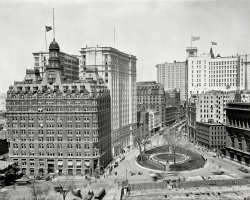
- Cement Ponds: 1940
- ... on the Potomac River.
A recent picture shows that the interior has been stripped to the steel girders.
Decor I like how the ... Posted by Dave - 07/25/2016 - 2:31pm -
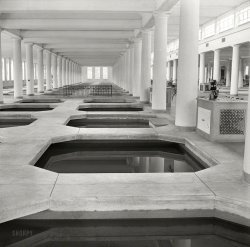
- War Work: 1943
- ... she came to Washington from North Dakota, worked at the Interior Department for the Grazing Service (now the BLM), and lived in a ... Posted by Dave - 05/04/2016 - 1:27pm -
![War Work: 1943 May 1943. Arlington, Va. "Idaho Hall, Arlington Farms, a residence for women working in government for the duration of the war." Medium format nitrate negative by Esther Bubley for the Office of War Information. View full size.
perfect picture for Mothers Day!That could have been my mom, too….except she came to Washington from North Dakota, worked at the Interior Department for the Grazing Service (now the BLM), and lived in a boarding house on R Street NW. She made Washington sound like the hub of the universe at that time, full of bright young people who came from all over the country to help out (and get decent jobs) with all the new agencies set up to end the Depression, and later, to step in when the men got sent off to war. My mom got sent out west to do payroll for the Grazing Service in Pocatello and Salt Lake City, making sure forest-fire fighters got paid; she ran into a lot of what she used to call 'guff' from the Western roughnecks because only men had ever had that job before. She said Salt Lake City was so dirty, she had to have 2 work dresses to alternate because she could only wear a dress once in the filthy air before it needed washing. During the war, office workers in Washington regularly worked overtime during the week, and worked on Saturdays for free, because there was a war on. There were plenty of small night clubs and dance joints, though…my mom remembers lots of dances and card parties at the boarding house too. Then she met my dad (who was 4-F) and that's how I came to be typing up this comment!
Reminds Me of my MotherMy mother was from Ohio but moved to Washington, D.C. during the war to work at the Civil Aeronautics Administration, the forerunner of the FAA. In fact she met my father, who was at Walter Reed Hospital recovering from war injuries, in 1943. This lady is not my mother but she does resemble her with the glasses. Don't know where my mother lived in D.C. during this time period.
Dumbo and his magic featherNice photo! My eye was immediately drawn to the cute sketch of Dumbo on the wall- because I love elephants! Disney's film Dumbo came out in 1941 and I believe it was quite popular. My children loved watching it over and over- I can probably still sing all the songs! In the movie, Timothy Mouse gave Dumbo a feather when he was up in the tree, saying it was "magic" so Dumbo wouldn't be afraid to fly-and he found he could fly! Later in the circus act, he loses the feather, but finds out he can fly without it!
The RingI am curious about that ring on her finger and the "Book" she is reading. The ring looks like a class ring, and the book looks like a hard back Bible.
[Only if Bibles have SHAKESPEARE on the back cover. - Dave]
Thanks Dave. Eyesight not what it used to be, even up close :>) [BAXADO]
Ok, thanks for the update on the ring.
Re: ring It's hard to be sure, but it looks like a Phi Gamma Delta fraternity ring, presumably from a fiancé.
(The Gallery, D.C., Esther Bubley, WW2)](https://www.shorpy.com/files/images/SHORPY-8d29771u.thumbnail.jpg)
- Up in Nebraska: 1934
- ... 1970s and took a guided tour of this building. Impressive interior.
The story the tour guide told was that those common sense farmers ... Posted by Dave - 01/16/2014 - 5:00pm -
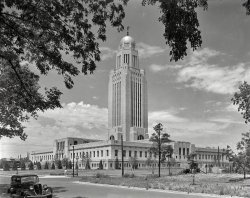
- Brownley Confectionery: 1924
- Washington, D.C., circa 1924. "Brownley interior." Our second peek inside the Brownley Confectionery on G Street. On ... Posted by Dave - 08/11/2011 - 9:23pm -
![Brownley Confectionery: 1924 Washington, D.C., circa 1924. "Brownley interior." Our second peek inside the Brownley Confectionery on G Street. On the table: more "Sport Fudge." National Photo Company Collection glass negative. View full size.
TilesThat's an interesting pattern. A bit time consuming, but very nice.
[These tiles came in sheets. - Dave]
I'd walk a mile... for some of their recipes!
[I'd walk a mile for a Caramel. - Dave]
Melts in your mouth, not in --Imagine the delicious aromas that would be in this shop. I wish this website offered "Smell-O-Vision." How did they keep the chocolates from melting during the summer months?
The screen doors don't look like they could keep out a determined fly. And is that a bird cage in the upper left corner - with a canary inside? A bit unsanitary for an upscale food vendor.
This is what heaven looks likeI love everything about this shop: the mosaic tile floor, the curved glass cases, the pressed tin ceiling and, hmmm, what else -- oh yeah, the CHOCOLATE!
PlantsMan they were really into palms and ferns in those days!
(The Gallery, D.C., Natl Photo, Stores & Markets)](https://www.shorpy.com/files/images/31630u.thumbnail.jpg)
- Use a Vapor Stove: 1901
- ... east bank of the James Creek Canal. According to a 1977 Interior Department report, "citizens fell into the unfenced waterway at an ... Posted by Dave - 02/02/2021 - 2:30pm -
![Use a Vapor Stove: 1901 Washington, D.C., circa 1901. "An elevated view from the Randall School's roof looking east to southeast -- Half & South Capitol Streets, and I & K Streets." Our title can be found on the left side of this 8x10 glass plate negative from the D.C. Street Survey Collection. View full size.
GlimpsesAt center left, we can see the stone-reinforced east bank of the James Creek Canal. According to a 1977 Interior Department report, "citizens fell into the unfenced waterway at an astounding rate, sometimes resulting in as many as one drowning per month." Eventually, the foul-smelling canal was converted into an underground sewer.
In the far distance to the left of the flagpole, we see the gasometer at 12th & M SE, which put in a cameo appearance on Shorpy some years back.
Ghosts Do you suppose the exposure was long enough that the person sitting down, and his ghostly friends, are the same people at the end of the street?
SmokestacksTil I looked at the Full Size version I assumed the plant (in front of the Stove Store) was running and the stack had an exhaust plume. Then I realized the smoke is a remnant on the negative.
[It is not a "remnant" (and the proper term would be "artifact"). - Dave]
No, thank you.I'll pass on the vapor stove. I have a hard enough time filling the lawn mower tank.
(The Gallery, D.C., D.C. Street Survey, Kids)](https://www.shorpy.com/files/images/SHORPY-40419a.thumbnail.jpg)
- Larkspur Eldorado: 1955
- ... in '54. It was white with a white top, black and white interior and had an aftermarket air-conditioner installed to make the trip ... Posted by tterrace - 06/29/2013 - 7:19pm -
![Larkspur Eldorado: 1955 1955 Cadillac Eldorado, photographed in the fall of that year by the nine-year-old me, then at the height of my kidhood car fascination. You can tell the part of the car that fascinated me most by how I aimed the camera. I also talked my brother into taking a Kodachrome slide of it. We were on one of the walks we were wont to take around our home town of Larkspur, California. This shot also captures, at the left, a significant moment in Larkspur history: the building of the first homes in the first major post-war housing development, Hillview Gardens. The houses sold in the low 20Ks. The following year the first kids from there started showing up in my classes at Larkspur-Corte Madera School. View full size.
Next yearIt's a 1956 Eldorado convertible. The 1955's had a completely different body style. A 1956 Eldorado convertible in very good condition might fetch over $100,000 today.
[Wrong, erroneous, incorrect. This is a 1955 Eldorado. Go do your homework, and no TV. - Dave]
Yup, '55Right you are Dave. The '56 had vertical strakes in the rear bumper ends and distinct teeth in the faux fender scoop.
'55 here: http://www.lov2xlr8.no/brochures/cadillac/1cad552.html
and here: http://www.lov2xlr8.no/brochures/cadillac/x551.html
'56 here: http://www.lov2xlr8.no/brochures/cadillac/cad56_1.html
I was smitten by those beauties as well at 10 years old!
BTW this is a great reference for IDing specific years: http://www.lov2xlr8.no/broch1.html
[The easiest way to tell the difference between the two years is from the rear: 1955 Eldos had a round exhaust port; in 1956 it was oblong.]
Not a poodleskirt in sightAccording to www.measuringwealth.com that $20k is now about $765k in economic power.
Where's the girl in the poodle skirt draped over those sexy fins?
[This being Larkspur, the homes in Hillview Gardens currently sell in the $1.1-$1.9 million range, the one in the photo for $1.29 million in 2011. -tterrace]
And so was Iat 11! We didn't realize it at the time, but we were getting a three-year preview of what the rear of a '58 Cadillac would look like!
Forty years ago this summer, a friend of mine and I drove a 1955 Eldorado convertible, freshly restored, from Waco, TX to the 20th Texas Tour in Kerville in the beautiful Hill Country where I had attended Camp Rio Vista in '54. It was white with a white top, black and white interior and had an aftermarket air-conditioner installed to make the trip comfortable. To show how recent those cars still appeared to everyone, when we drove it in the big parade through downtown Kerrville, people would shout "Hey, that's not an old car!" That's when cars from the early 1900's were still the main attraction at tours.
Moving in?A small family could probably live in that trunk.
1956 CadillacMy first interest in Cadillac cars was in 1949 when my future father-in-law had a 1947 4 door sedan. For a few years he would get a two year old car from his brother every two years, I don't have a picture. Then in 1956 my cousin Jessie Carr of Carr Town (now known as Stafford Township, NJ) bought a two door. The following year I turned 17 and was able to drive it. Then in 1985 I bought my first two door front wheel drive Cadillac, it was new. During the next 28 years I bought various Cadillacs both front wheel and rear wheel drive, some were new. I had a 1978 rear wheel drive that was driven 400,000 miles and the engine was never opened and the transmission was OK too. But, I finally sent it to the scrap yard. We just purchased a 2001 DeVille that immediately required an engine replacement. It seems to be a good choice and this is the tenth Cadillac. I have driven 2 million miles in Cadillac cars, they are the best. The 1956 is pictured here.
(ShorpyBlog, Member Gallery, tterrapix)](https://www.shorpy.com/files/images/eldorado_0242.thumbnail.jpg)
- Bureau of Mines: 1917
- ... I don't think, but under the purview of the Dept. of the Interior.
The Three Stooges Man, those are some scary looking ... Posted by Dave - 11/27/2012 - 12:50pm -
